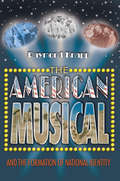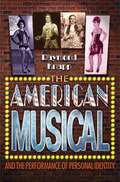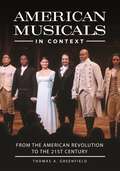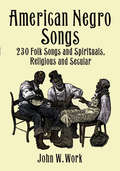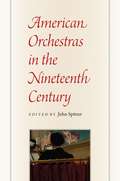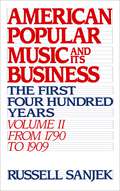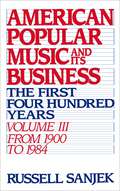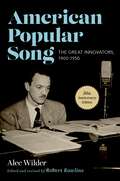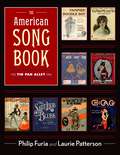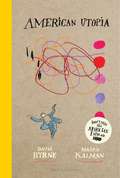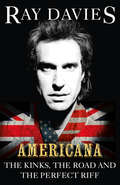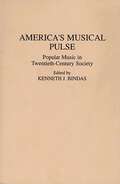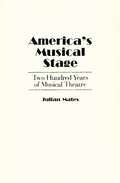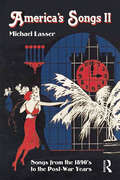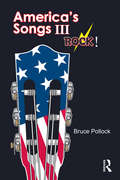- Table View
- List View
The American Musical and the Formation of National Identity
by Raymond KnappThe American musical has achieved and maintained relevance to more people in America than any other performance-based art. This thoughtful history of the genre, intended for readers of all stripes, offers probing discussions of how American musicals, especially through their musical numbers, advance themes related to American national identity. Written by a musicologist and supported by a wealth of illustrative audio examples (on the book's website), the book examines key historical antecedents to the musical, including the Gilbert and Sullivan operetta, nineteenth and early twentieth-century American burlesque and vaudeville, Tin Pan Alley, and other song types. It then proceeds thematically, focusing primarily on fifteen mainstream shows from the twentieth century, with discussions of such notable productions as Show Boat (1927), Porgy and Bess (1935), Oklahoma! (1943), West Side Story (1957), Hair (1967), Pacific Overtures (1976), and Assassins (1991). The shows are grouped according to their treatment of themes that include defining America, mythologies, counter-mythologies, race and ethnicity, dealing with World War II, and exoticism. Each chapter concludes with a brief consideration of available scholarship on related subjects; an extensive appendix provides information on each show discussed, including plot summaries and song lists, and a listing of important films, videos, audio recordings, published scores, and libretti associated with each musical.
The American Musical and the Formation of National Identity (pdf)
by Raymond KnappThe American musical has achieved and maintained relevance to more people in America than any other performance-based art. This thoughtful history of the genre, intended for readers of all stripes, offers probing discussions of how American musicals, especially through their musical numbers, advance themes related to American national identity. Written by a musicologist and supported by a wealth of illustrative audio examples (on the book's website), the book examines key historical antecedents to the musical, including the Gilbert and Sullivan operetta, nineteenth and early twentieth-century American burlesque and vaudeville, Tin Pan Alley, and other song types. It then proceeds thematically, focusing primarily on fifteen mainstream shows from the twentieth century, with discussions of such notable productions as Show Boat (1927), Porgy and Bess (1935), Oklahoma! (1943), West Side Story (1957), Hair (1967), Pacific Overtures (1976), and Assassins (1991). The shows are grouped according to their treatment of themes that include defining America, mythologies, counter-mythologies, race and ethnicity, dealing with World War II, and exoticism. Each chapter concludes with a brief consideration of available scholarship on related subjects; an extensive appendix provides information on each show discussed, including plot summaries and song lists, and a listing of important films, videos, audio recordings, published scores, and libretti associated with each musical.
The American Musical and the Performance of Personal Identity
by Raymond KnappThe American musical has long provided an important vehicle through which writers, performers, and audiences reimagine who they are and how they might best interact with the world around them. Musicals are especially good at this because they provide not only an opportunity for us to enact dramatic versions of alternative identities, but also the material for performing such alternatives in the real world, through songs and the characters and attitudes those songs project. This book addresses a variety of specific themes in musicals that serve this general function: fairy tale and fantasy, idealism and inspiration, gender and sexuality, and relationships, among others. It also considers three overlapping genres that are central, in quite different ways, to the projection of personal identity: operetta, movie musicals, and operatic musicals. Among the musicals discussed are Camelot, Candide; Chicago; Company; Evita; Gypsy; Into the Woods; Kiss Me, Kate; A Little Night Music; Man of La Mancha; Meet Me in St. Louis; The Merry Widow; Moulin Rouge; My Fair Lady; Passion; The Rocky Horror Picture Show; Singin' in the Rain; Stormy Weather; Sweeney Todd; and The Wizard of Oz. Complementing the author's earlier work, The American Musical and the Formation of National Identity, this book completes a two-volume thematic history of the genre, designed for general audiences and specialists alike.
The American Musical and the Performance of Personal Identity
by Raymond KnappThe American musical has long provided an important vehicle through which writers, performers, and audiences reimagine who they are and how they might best interact with the world around them. Musicals are especially good at this because they provide not only an opportunity for us to enact dramatic versions of alternative identities, but also the material for performing such alternatives in the real world, through songs and the characters and attitudes those songs project. This book addresses a variety of specific themes in musicals that serve this general function: fairy tale and fantasy, idealism and inspiration, gender and sexuality, and relationships, among others. It also considers three overlapping genres that are central, in quite different ways, to the projection of personal identity: operetta, movie musicals, and operatic musicals. Among the musicals discussed are Camelot, Candide; Chicago; Company; Evita; Gypsy; Into the Woods; Kiss Me, Kate; A Little Night Music; Man of La Mancha; Meet Me in St. Louis; The Merry Widow; Moulin Rouge; My Fair Lady; Passion; The Rocky Horror Picture Show; Singin' in the Rain; Stormy Weather; Sweeney Todd; and The Wizard of Oz. Complementing the author's earlier work, The American Musical and the Formation of National Identity, this book completes a two-volume thematic history of the genre, designed for general audiences and specialists alike.
American Musicals in Context: From the American Revolution to the 21st Century
by Thomas A. GreenfieldAmerican Musicals in Context: From the American Revolution to the 21st Century gives students a fresh look at history-based musicals, helping readers to understand the American story through one of the country's most celebrated art forms: the musical.With the hit musical Hamilton (2015) captivating audiences and reshaping the way early U.S. history is taught and written about, this book offers insight into an array of musicals that explore U.S. history. The work provides a synopsis, overview of critical and audience reception, and historical context and analysis for each of 20 musicals selected for the unique and illuminating way they present the American story on the stage.Specifically, this volume explores musicals that have centered their themes, characters, and plots on some aspect of America's complex and ever-changing history. Each in its own way helps us rediscover pivotal national crises, key political decisions, defining moral choices, unspeakable and unresolved injustices, important and untold stories, defeats suffered, victories won in the face of monumental adversity, and the sacrifices borne publicly and privately in the process of creating the American narrative, one story at a time. Students will come away from the volume armed with the critical thinking skills necessary to discern fact from fiction in U.S. history.
American Musicals in Context: From the American Revolution to the 21st Century
by Thomas A. GreenfieldAmerican Musicals in Context: From the American Revolution to the 21st Century gives students a fresh look at history-based musicals, helping readers to understand the American story through one of the country's most celebrated art forms: the musical.With the hit musical Hamilton (2015) captivating audiences and reshaping the way early U.S. history is taught and written about, this book offers insight into an array of musicals that explore U.S. history. The work provides a synopsis, overview of critical and audience reception, and historical context and analysis for each of 20 musicals selected for the unique and illuminating way they present the American story on the stage.Specifically, this volume explores musicals that have centered their themes, characters, and plots on some aspect of America's complex and ever-changing history. Each in its own way helps us rediscover pivotal national crises, key political decisions, defining moral choices, unspeakable and unresolved injustices, important and untold stories, defeats suffered, victories won in the face of monumental adversity, and the sacrifices borne publicly and privately in the process of creating the American narrative, one story at a time. Students will come away from the volume armed with the critical thinking skills necessary to discern fact from fiction in U.S. history.
American Negro Songs: 230 Folk Songs and Spirituals, Religious and Secular
by John W. WorkFrom joyous gospel to deeply felt blues, this wonderful collection contains vintage songs sung and played through the years by black Americans — at work, in church, and for pure entertainment. Included are spirituals, blues, work songs, and a variety of social and dance songs.This important volume was originally compiled in 1940 by Dr. John W. Work, the noted musicologist affiliated with Fisk University and the celebrated Fisk Jubilee Singers. In it, he discusses the origins and history of black American folk music, the influence of slavery and African cultures, and the lyric significance of such much-loved songs as "Swing Low, Sweet Chariot," Steal Away to Jesus," "Lord, I Want to Be a Christian," and "John Henry." These informative notes lead up to the heart of the book: the complete words and music for 230 religious and secular songs, including "Study War No More," "Keep Me from Sinking Down," "You May Bury Me in the East," "Rock of Ages," "Go Tell It on the Mountain," and many others.This is an indispensable treasury of music for singers, musicians and all readers seeking a comprehensive sourcebook of black American folk music. It will be equally welcomed at parties, family get-togethers, sing-alongs, church events, and other gatherings where people want to play and sing these classic folk songs that are an integral part of American musical history.
American Orchestras in the Nineteenth Century
by John SpitzerStudies of concert life in nineteenth-century America have generally been limited to large orchestras and the programs we are familiar with today. But as this book reveals, audiences of that era enjoyed far more diverse musical experiences than this focus would suggest. To hear an orchestra, people were more likely to head to a beer garden, restaurant, or summer resort than to a concert hall. And what they heard weren’t just symphonic works—programs also included opera excerpts and arrangements, instrumental showpieces, comic numbers, and medleys of patriotic tunes. This book brings together musicologists and historians to investigate the many orchestras and programs that developed in nineteenth-century America. In addition to reflecting on the music that orchestras played and the socioeconomic aspects of building and maintaining orchestras, the book considers a wide range of topics, including audiences, entrepreneurs, concert arrangements, tours, and musicians’ unions. The authors also show that the period saw a massive influx of immigrant performers, the increasing ability of orchestras to travel across the nation, and the rising influence of women as listeners, patrons, and players. Painting a rich and detailed picture of nineteenth-century concert life, this collection will greatly broaden our understanding of America’s musical history.
American Orchestras in the Nineteenth Century
by John SpitzerStudies of concert life in nineteenth-century America have generally been limited to large orchestras and the programs we are familiar with today. But as this book reveals, audiences of that era enjoyed far more diverse musical experiences than this focus would suggest. To hear an orchestra, people were more likely to head to a beer garden, restaurant, or summer resort than to a concert hall. And what they heard weren’t just symphonic works—programs also included opera excerpts and arrangements, instrumental showpieces, comic numbers, and medleys of patriotic tunes. This book brings together musicologists and historians to investigate the many orchestras and programs that developed in nineteenth-century America. In addition to reflecting on the music that orchestras played and the socioeconomic aspects of building and maintaining orchestras, the book considers a wide range of topics, including audiences, entrepreneurs, concert arrangements, tours, and musicians’ unions. The authors also show that the period saw a massive influx of immigrant performers, the increasing ability of orchestras to travel across the nation, and the rising influence of women as listeners, patrons, and players. Painting a rich and detailed picture of nineteenth-century concert life, this collection will greatly broaden our understanding of America’s musical history.
American Orchestras in the Nineteenth Century
by John SpitzerStudies of concert life in nineteenth-century America have generally been limited to large orchestras and the programs we are familiar with today. But as this book reveals, audiences of that era enjoyed far more diverse musical experiences than this focus would suggest. To hear an orchestra, people were more likely to head to a beer garden, restaurant, or summer resort than to a concert hall. And what they heard weren’t just symphonic works—programs also included opera excerpts and arrangements, instrumental showpieces, comic numbers, and medleys of patriotic tunes. This book brings together musicologists and historians to investigate the many orchestras and programs that developed in nineteenth-century America. In addition to reflecting on the music that orchestras played and the socioeconomic aspects of building and maintaining orchestras, the book considers a wide range of topics, including audiences, entrepreneurs, concert arrangements, tours, and musicians’ unions. The authors also show that the period saw a massive influx of immigrant performers, the increasing ability of orchestras to travel across the nation, and the rising influence of women as listeners, patrons, and players. Painting a rich and detailed picture of nineteenth-century concert life, this collection will greatly broaden our understanding of America’s musical history.
American Orchestras in the Nineteenth Century
by John SpitzerStudies of concert life in nineteenth-century America have generally been limited to large orchestras and the programs we are familiar with today. But as this book reveals, audiences of that era enjoyed far more diverse musical experiences than this focus would suggest. To hear an orchestra, people were more likely to head to a beer garden, restaurant, or summer resort than to a concert hall. And what they heard weren’t just symphonic works—programs also included opera excerpts and arrangements, instrumental showpieces, comic numbers, and medleys of patriotic tunes. This book brings together musicologists and historians to investigate the many orchestras and programs that developed in nineteenth-century America. In addition to reflecting on the music that orchestras played and the socioeconomic aspects of building and maintaining orchestras, the book considers a wide range of topics, including audiences, entrepreneurs, concert arrangements, tours, and musicians’ unions. The authors also show that the period saw a massive influx of immigrant performers, the increasing ability of orchestras to travel across the nation, and the rising influence of women as listeners, patrons, and players. Painting a rich and detailed picture of nineteenth-century concert life, this collection will greatly broaden our understanding of America’s musical history.
American Orchestras in the Nineteenth Century
by John SpitzerStudies of concert life in nineteenth-century America have generally been limited to large orchestras and the programs we are familiar with today. But as this book reveals, audiences of that era enjoyed far more diverse musical experiences than this focus would suggest. To hear an orchestra, people were more likely to head to a beer garden, restaurant, or summer resort than to a concert hall. And what they heard weren’t just symphonic works—programs also included opera excerpts and arrangements, instrumental showpieces, comic numbers, and medleys of patriotic tunes. This book brings together musicologists and historians to investigate the many orchestras and programs that developed in nineteenth-century America. In addition to reflecting on the music that orchestras played and the socioeconomic aspects of building and maintaining orchestras, the book considers a wide range of topics, including audiences, entrepreneurs, concert arrangements, tours, and musicians’ unions. The authors also show that the period saw a massive influx of immigrant performers, the increasing ability of orchestras to travel across the nation, and the rising influence of women as listeners, patrons, and players. Painting a rich and detailed picture of nineteenth-century concert life, this collection will greatly broaden our understanding of America’s musical history.
American Orchestras in the Nineteenth Century
by John SpitzerStudies of concert life in nineteenth-century America have generally been limited to large orchestras and the programs we are familiar with today. But as this book reveals, audiences of that era enjoyed far more diverse musical experiences than this focus would suggest. To hear an orchestra, people were more likely to head to a beer garden, restaurant, or summer resort than to a concert hall. And what they heard weren’t just symphonic works—programs also included opera excerpts and arrangements, instrumental showpieces, comic numbers, and medleys of patriotic tunes. This book brings together musicologists and historians to investigate the many orchestras and programs that developed in nineteenth-century America. In addition to reflecting on the music that orchestras played and the socioeconomic aspects of building and maintaining orchestras, the book considers a wide range of topics, including audiences, entrepreneurs, concert arrangements, tours, and musicians’ unions. The authors also show that the period saw a massive influx of immigrant performers, the increasing ability of orchestras to travel across the nation, and the rising influence of women as listeners, patrons, and players. Painting a rich and detailed picture of nineteenth-century concert life, this collection will greatly broaden our understanding of America’s musical history.
American Popular Music and Its Business: The First Four Hundred Years
by the late Russell SanjekVolume two concentrates exclusively on music activity in the United States in the nineteenth century. Among the topics discussed are how changing technology affected the printing of music, the development of sheet music publishing, the growth of the American musical theater, popular religious music, black music (including spirituals and ragtime), music during the Civil War, and finally "music in the era of monopoly," including such subjects as copyright, changing technology and distribution, invention of the phonograph, copyright revision, and the establishment of Tin Pan Alley.
American Popular Music and Its Business: The First Four Hundred Years, Volume III: From 1900-1984
by the late Russell SanjekThis volume focuses on developments in the music business in the twentieth century, including vaudeville, music boxes, the relationship of Hollywood to the music business, the "fall and rise" of the record business in the 1930s, new technology (TV, FM, and the LP record) after World War II, the dominance of rock-and-roll and the huge increase in the music business during the 1950s and 1960s, and finally the changing music business scene from 1967 to the present, especially regarding government regulations, music licensing, and the record business.
American Popular Song: The Great Innovators, 1900-1950
by Alec Wilder"Wonderful"--The New York Times. "Provocative, opinionated, and never dull"--Down Beat. "A singular book."--Studs Terkel. When it was first published, Alec Wilder's American Popular Song quickly became a classic and today it remains essential reading for countless musicians, lovers of American Song, and fans of Alec Wilder. Now, in a 50th anniversary edition, popular music scholar Robert Rawlins brings the book fully up-to-date for the 21st century. Whereas previous editions featured only piano scores, the format has been changed to lead sheet notation with lyrics, making it accessible to a wider readership. Rawlins has also added more than sixty music examples to help complete the chapter on Irving Berlin. One of the most fascinating features of the original edition was Wilder's inventive use of language, often revealing his strong and sometimes irreverent opinions. Wilder's prose remains relatively unaltered, but footnotes have been provided that clarify, elucidate, and even correct. Moreover, a new chapter has been added, discussing fifty-three songs by numerous composers that Wilder might have well included but was not able to. Songs by Ann Ronnell, Fats Waller, Jule Styne and many others are capped off with an examination of ten of Wilder's own songs.
American Popular Song: The Great Innovators, 1900-1950
by Alec Wilder"Wonderful"--The New York Times. "Provocative, opinionated, and never dull"--Down Beat. "A singular book."--Studs Terkel. When it was first published, Alec Wilder's American Popular Song quickly became a classic and today it remains essential reading for countless musicians, lovers of American Song, and fans of Alec Wilder. Now, in a 50th anniversary edition, popular music scholar Robert Rawlins brings the book fully up-to-date for the 21st century. Whereas previous editions featured only piano scores, the format has been changed to lead sheet notation with lyrics, making it accessible to a wider readership. Rawlins has also added more than sixty music examples to help complete the chapter on Irving Berlin. One of the most fascinating features of the original edition was Wilder's inventive use of language, often revealing his strong and sometimes irreverent opinions. Wilder's prose remains relatively unaltered, but footnotes have been provided that clarify, elucidate, and even correct. Moreover, a new chapter has been added, discussing fifty-three songs by numerous composers that Wilder might have well included but was not able to. Songs by Ann Ronnell, Fats Waller, Jule Styne and many others are capped off with an examination of ten of Wilder's own songs.
The American Song Book: The Tin Pan Alley Era
by Philip Furia Laurie J. PattersonThe American Song Book, Volume I: The Tin Pan Alley Era is the first in a projected five-volume series of books that will reprint original sheet music, including covers, of songs that constitute the enduring standards of Irving Berlin, Jerome Kern, the Gershwins, and other lyricists and composers of what has been called the "Golden Age" of American popular music. These songs have done what popular songs are not supposed to do-stayed popular. They have been reinterpreted year after year, generation after generation, by jazz artists such as Charlie Parker and Art Tatum, Ella Fitzgerald and Louis Armstrong. In the 1950s, Frank Sinatra began recording albums of these standards and was soon followed by such singers as Tony Bennet, Doris Day, Willie Nelson, and Linda Ronstadt. In more recent years, these songs have been reinterpreted by Rod Stewart, Harry Connick, Jr., Carly Simon, Lady GaGa, K.D. Laing, Paul McCartney, and, most recently, Bob Dylan. As such, these songs constitute the closest thing America has to a repertory of enduring classical music. In addition to reprinting the sheet music for these classic songs, authors Philip Furia and Laurie Patterson place these songs in historical context with essays about the sheet-music publishing industry known as Tin Pan Alley, the emergence of American musical comedy on Broadway, and the "talkie" revolution that made possible the Hollywood musical. The authors also provide biographical sketches of songwriters, performers, and impresarios such as Florenz Ziegfeld. In addition, they analyze the lyrical and musical artistry of each song and relate anecdotes, sometimes amusing, sometimes poignant, about how the songs were created. The American Songbook is a book that can be read for enjoyment on its own or be propped on the piano to be played and sung.
American Utopia
by Maira Kalman David ByrneFrom former Talking Heads frontman and multimedia visionary David Byrne and revered bestselling author, illustrator, and artist Maira Kalman--an inspiring celebration in words and art of the connections between us all. Don't miss the Spike Lee film of the Broadway hit American Utopia--on HBO.A joyful collaboration between old friends David Byrne and Maira Kalman, American Utopia offers readers an antidote to cynicism, bursting with pathos, humanism, and hope--featuring his words and lyrics brought to life with more than 150 of her colorful paintings.The text is drawn from David Byrne's American Utopia, which has become a hit Broadway show and is soon to be a documentary from Spike Lee. The four-color artwork, by Maira Kalman, which she created for the Broadway show's curtain, is composed of small moments, expressions, gestures, and interactions that together offer a portrait of daily life and coexistence.With their creative talents combined, American Utopia is a salvo for kindness and a call for jubilation, a reminder to sing, dance, and waste not a moment. Beautifully designed and edited by Alex Kalman, American Utopia is a balm for the soul from two of the world's most extraordinary artists.
Americana: The Kinks, the Road and the Perfect Riff
by Ray DaviesAs a boy in post-War England, legendary Kinks singer/songwriter Ray Davies fell in love with America – its movies and music, its culture of freedom fed his imagination. In Americana, Davies tries to make sense of his long love-hate relationship with the country that both inspires and frustrates him, and where he nearly lost his life in a street shooting. Some of the most fascinating characters in pop culture and the British Invasion make appearances, from the famous to the behind-the-scenes players. The book is interspersed with lyrics and also includes photographs from Davies's own collection and the Kinks’ archive. From his quintessentially English perspective, Davies – with candour, humour, and wit – takes us on a very personal road trip through his life and storied career as a rock star, and reveals what music, fame and America really mean to him.
America's Musical Pulse: Popular Music in Twentieth-Century Society
by Kenneth J. BindasPopular music may be viewed as primary documents of society, and America's Musical Pulse documents the American experience as recorded in popular sound. Whether jazz, blues, swing, country, or rock, the music, the impulse behind it, and the reaction to it reveal the attitudes of an era or generation. Always a major preoccupation of students, music is often ignored by teaching professionals, who might profitably channel this interest to further understandings of American social history and such diverse fields as sociology, political science, literature, communications, and business as well as music.In this interdisciplinary collection, scholars, educators, and writers from a variety of fields and perspectives relate topics concerning twentieth-century popular music to issues of politics, class, economics, race, gender, and the social context. The focus throughout is to place music in societal perspective and encourage investigation of the complex issues behind the popular tunes, rhythms, and lyrics.
America's Musical Stage: Two Hundred Years of Musical Theatre
by Julian Mates[This book is] a comprehensive illustrated history of the U.S. musical from its colonial origins to the present, tracing the connections and influences of the minstrel show, operetta, burlesque, melodrama, revues, circus, dance, musical comedy, the Broadway opera, the book musical and other forms. . . . Further, Mates introduces readers to inside stuff--the various types of musical performers. VarietyAmerican musical theatre has developed as an idigenous art form, with a long history, amazing vitality, and a variety of expression. Julian Mates is the first to show the musical stage in all its guises--from burlesque to musical comedy to grand opera--from its beginning in pre-Revolutionary America to the present day. In addition, this book is the first to explore the relationships between the various forms of musical theatre.
America's Songs II: Songs from the 1890s to the Post-War Years
by Michael LasserAmerica’s Songs II: Songs from the 1890's to the Post-War Years continues to tell the stories behind popular songs in our country’s history, serving as a sequel to the bestselling America’s Songs: Stories Behind the Songs of Broadway, Hollywood, and Tin Pan Alley. Beginning in 1890 and ending in post-war America, America's Songs II is a testament to the richness of popular music in the first half of the 20th century. This volume builds on the unique features of the first volume, delving deeper into the nature of the collaboration between well-known songwriters of the time but also shedding light on some of the early performers to turn songs into hits. The book’s structure – a collection of short easy-to-read essays – allows the author to provide historical context to certain songs, but also to demonstrate how individual songs facilitated the popularity of specific genres, including ragtime, jazz, and blues, which subsequently reshaped the landscape of American popular music. America’s Songs II: Songs from the 1890's to the Post-War Years will appeal to American popular music enthusiasts but will also serve as an ideal reference guide for students or as a supplement in American music courses.
America's Songs II: Songs from the 1890s to the Post-War Years
by Michael LasserAmerica’s Songs II: Songs from the 1890's to the Post-War Years continues to tell the stories behind popular songs in our country’s history, serving as a sequel to the bestselling America’s Songs: Stories Behind the Songs of Broadway, Hollywood, and Tin Pan Alley. Beginning in 1890 and ending in post-war America, America's Songs II is a testament to the richness of popular music in the first half of the 20th century. This volume builds on the unique features of the first volume, delving deeper into the nature of the collaboration between well-known songwriters of the time but also shedding light on some of the early performers to turn songs into hits. The book’s structure – a collection of short easy-to-read essays – allows the author to provide historical context to certain songs, but also to demonstrate how individual songs facilitated the popularity of specific genres, including ragtime, jazz, and blues, which subsequently reshaped the landscape of American popular music. America’s Songs II: Songs from the 1890's to the Post-War Years will appeal to American popular music enthusiasts but will also serve as an ideal reference guide for students or as a supplement in American music courses.
America's Songs III: Rock!
by Bruce PollockAmerica’s Songs III: Rock! picks up in 1953 where America’s Songs II left off, describing the artistic and cultural impact of the rock ’n’ roll era on America’s songs and songwriters, recording artists and bands, music publishers and record labels, and the all-important consuming audience. The Introduction presents the background story, discussing the 1945-1952 period and focusing on the key songs from the genres of jump blues, rhythm ’n’ blues, country music, bluegrass, and folk that combined to form rock ‘n’ roll. From there, the author selects a handful of songs from each subsequent year, up through 2015, listed chronologically and organized by decade. As with its two preceding companions, America’s Songs III highlights the most important songs of each year with separate entries. More than 300 songs are analyzed in terms of importance—both musically and historically—and weighted by how they defined an era, an artist, a genre, or an underground movement. Written by known rock historian and former ASCAP award winner Bruce Pollock, America’s Songs III: Rock! relays the stories behind America’s musical history.
